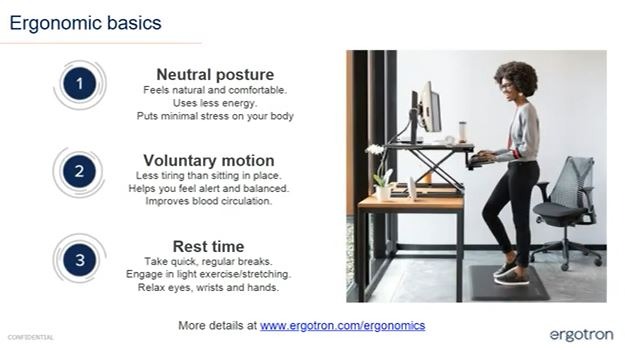How to build an employee-first, wellness-fueled work environment
Ergotron’s CEO shares guidance on creating a flexible, health-minded workplace suited to your employees’ needs.

Creating a workplace culture that uplifts, motivates and empowers employees is essential to business success. But how can you create and sustain a vibrant culture when many employees work remotely?
Ergotron CEO Chad Severson shared four big ideas in a recent webinar:
1. Facilitate flexible, comfortable work locations. Severson says companies must be equipped to support hybrid, work-from-anywhere teams for the long haul. That goes beyond merely “permitting” employees to work from home, too.
Companies should invest in top-notch, ergonomic home office equipment for their workers—and bend over backward (after stretching, of course) to ensure workers feel like their workspace is a haven of health rather than a den of stress.
Severson shared some ergonomic basics:

2. Prioritize connecting personally. Severson touts the importance of one-on-one conversations—especially as we continue to endure the isolation and chaos of the pandemic. “Managers must make time for frequent communication and check-ins,” Severson says.
It’s a matter of focusing on what matters, Severson says. He advises investing heavily in your onboarding process—and going the extra mile to ensure workers feel heard, appreciated and validated. “Time-in-seat is irrelevant now. It matters how you treat employees and customers.
Prioritizing personal connections is an important bulwark against mental health stressors. Successful companies have cultures where it’s OK (and encouraged) to ask for help. Top companies also frequently promote employee resource groups to facilitate meaningful connections, as well as consistently tout mental health perks, resources and benefits.
Employee wellness is a “marathon, not a sprint,” Severson says. So make plans for long-term investment into a holistic view of employee well-being.
3. Empathy is key. Your employees’ needs, concerns and preferences should shape your company’s return-to-office plans. That is, if you even decide to reconvene in a physical location.
True empathy could mean changing your business model to suit your employees’ post-COVID lifestyles and limitations.
4. Experiment and learn. It’s vital to continue fostering creativity and innovation in a remote setting, Severson says. He notes that Ergotron removed cubicles from a common office area and set up a “Collaboration Lab” with mobile, standing desks for workers who were eager to return to an office setting.
You might also need to reconsider how you’ll meet customers’ needs in new ways. Severson shares that Ergotron converted an office into a “virtual demonstration room,” where salespeople could show how products work via video.
Cultivating a movement mindset of healthy behaviors starts at the top, Severson says. He urges leaders to convey your culture by demonstration. Severson sends out frequent videos to employees to reinforce healthy habits, and he says the company uses “walking meetings” to keep people moving during the day. “Leadership by example speaks volumes,” he says.
Severson offers plenty more practical solutions to help companies build healthy and flexible work environments that staffers will love. This thoughtful, timely webinar will equip leaders, HR pros and wellness practitioners with helpful tips to support employee retention, engagement and well-being. Watch today, and start shaping a healthier, employee-first culture.







